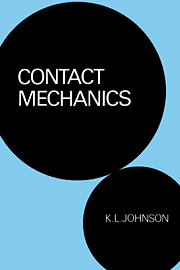Book contents
- Frontmatter
- Contents
- Preface
- 1 Motion and forces at a point of contact
- 2 Line loading of an elastic half-space
- 3 Point loading of an elastic half-space
- 4 Normal contact of elastic solids – Hertz theory
- 5 Non-Hertzian normal contact of elastic bodies
- 6 Normal contact of inelastic solids
- 7 Tangential loading and sliding contact
- 8 Rolling contact of elastic bodies
- 9 Rolling contact of inelastic bodies
- 10 Calendering and lubrication
- 11 Dynamic effects and impact
- 12 Thermoelastic contact
- 13 Rough surfaces
- Appendices
- References and author index
- Subject index
5 - Non-Hertzian normal contact of elastic bodies
Published online by Cambridge University Press: 05 June 2012
- Frontmatter
- Contents
- Preface
- 1 Motion and forces at a point of contact
- 2 Line loading of an elastic half-space
- 3 Point loading of an elastic half-space
- 4 Normal contact of elastic solids – Hertz theory
- 5 Non-Hertzian normal contact of elastic bodies
- 6 Normal contact of inelastic solids
- 7 Tangential loading and sliding contact
- 8 Rolling contact of elastic bodies
- 9 Rolling contact of inelastic bodies
- 10 Calendering and lubrication
- 11 Dynamic effects and impact
- 12 Thermoelastic contact
- 13 Rough surfaces
- Appendices
- References and author index
- Subject index
Summary
The assumptions and restrictions made in the Hertz theory of elastic contact were outlined in the previous chapter: parabolic profiles, frictionless surfaces, elastic half-space theory. In this chapter some problems of normal elastic contact are considered in which we relax one or more of these restrictions. Before looking at particular situations, however, it is instructive to examine the stress conditions which may arise close to the edge of contact.
Stress conditions at the edge of contact
We have seen in Chapter 4 that, when two non-conforming elastic bodies having continuous profiles are pressed into contact, the pressure distribution between them is not determined uniquely by the profiles of the bodies within the contact area. Two further conditions have to be satisfied: (i) that the interface should not carry any tension and (ii) that the surfaces should not interfere outside the contact area. These conditions eliminate terms in the pressure distribution of the form C(1 –x2/a2)-1/2 which give rise to an infinite tension or compression at the edge of the contact area (x = ±a) (see equation (4.41)). The resulting pressure distribution was found to be semi-ellipsoidal, i.e. of the form p0(1 –x2/a2)1/2, which falls to zero at x = ±a.
If we now recall the stresses produced in line loading by a uniform distribution of pressure (§2.5), they are everywhere finite, but the gradient of the surface is infinite at the edge of the contact (eq. (230b) and Fig. 2.8).
- Type
- Chapter
- Information
- Contact Mechanics , pp. 107 - 152Publisher: Cambridge University PressPrint publication year: 1985
- 6
- Cited by



